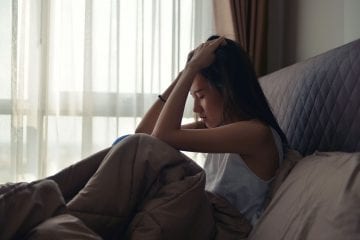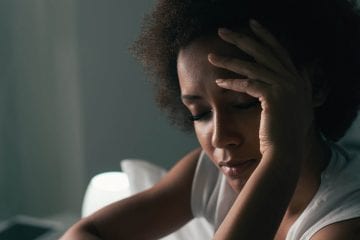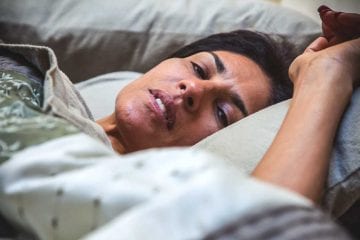Our breathing patterns change during sleep. The breathing rate slightly decreases and becomes very regular as we progress through the stages of nREM sleep, while breathing during REM sleep is somewhat discordant. However, when it stops periodically it becomes a cause for alarm.
Someone who suffers from obstructive sleep apnea (OSA) is unable to inhale normally due to upper airway collapse. Symptoms of obstructive sleep apnea include high blood pressure, loud snoring, and excessive daytime sleepiness. This condition is quite common and can be normally corrected with positive airway pressure (CPAP).
When the brain fails to send the right signals to the muscles that regulate breathing during sleep, lack of oxygen causes the patient to wake up briefly and take a breath. Breathing may repeatedly stop and start throughout the night; this disorder is known as central sleep apnea.
There are several factors that may also cause this condition including stroke and heart failure. It may also be affected by sleeping at high altitudes.
Table of Contents
Symptoms of central sleep apnea
- Shortness of breath that is relieved by sitting up
- Excessive daytime sleepiness (hypersomnia)
- Morning headaches
- Mood changes
- Chest pain at night
- Difficulty concentrating
- Abnormal breathing patterns during sleep
- Awakening with a sharp intake of air (gasping)
- Snoring
However, snoring as a symptom is not as common in central sleep apnea as it is in obstructive sleep apnea.
Causes of central sleep apnea
The brainstem links your brain to your spinal cord and controls functions such as the heart rate and breathing among other things. The main cause of central sleep apnea is a failure of the brainstem to regulate your breathing pattern.
The cause varies with the type of central sleep apnea. The types include:
Primary central sleep apnea of infancy - This condition is associated with babies born prematurely. There is no definitive cause, but researchers suggest that it may happen because the brainstem is underdeveloped and doesn’t regulate breathing properly.
Primary (idiopathic) central sleep apnea - the cause is unknown.
Medical condition induced central sleep apnea - instances of central sleep apnea caused by several medical conditions such as stroke and end-stage kidney disease.
Treatment-emergent central sleep apnea - Central sleep apnea may develop during the treatment of obstructive sleep apnea by use of continuous positive air pressure (CPAP).
High-altitude periodic breathing - a breathing pattern that appears when an individual is exposed to altitudes above 15,000 feet. Changes in oxygen at high altitudes can cause underbreathing or hyperventilation (alternating rapid breathing).
Drug-induced apnea - Certain drugs and medications such as opioids, codeine, oxycodone, and morphine may cause breathing problems.
Cheyne-Stokes breathing - Cheyne-Stokes breathing is characterized by an increase and then gradual decrease in breathing and airflow; the pattern repeats during the night. This type of central sleep apnea is associated with stroke or congestive heart failure.
Complications of central sleep apnea
Some complications of central sleep apnea can include:
Cardiovascular problems - Sudden drops in blood oxygen that occur during central sleep apnea can affect the health of your heart. The risk of abnormal heart rhythms increases due to repeated low blood oxygen exposure during sleep.
Fatigue - Frequent awakenings associated with sleep apnea lead to lack of restorative sleep. People with central sleep apnea may experience bouts of irritability, daytime drowsiness, and fatigue.
Difficulty concentrating and falling asleep at work are two symptoms of CSA. If you get sleepy while watching television or when driving, you should see your doctor immediately. Falling asleep is particularly dangerous when you are behind the wheel of a car. Drowsy driving is a major cause of auto accidents in the U.S. and the world. Avoid driving during times when you are particularly tired or feel sleepy.
Who is affected by central sleep apnea?
Opioid users - opioid medications may increase the risk of central sleep apnea.
People at high altitudes - sleeping at high altitudes may increase your risk of sleep apnea.
People with other medical conditions that occur with central sleep apnea include:
- Brain damage caused by stroke, encephalitis, or other injuries
- Neurological diseases such as Alzheimer's disease Parkinson's disease, and amyotrophic lateral sclerosis (ALS)
- Congestive heart failure
- Atrial fibrillation (irregular heartbeats)
- Kidney failure
- Hypothyroid Disease.
CPAP users - some people who have obstructive sleep apnea develop central sleep apnea while using a CPAP machine.
Males - men tend to be more at risk of both central and obstructive sleep apnea. Another risk factor for OSA is obesity, though it is generally not considered a risk factor for CSA. However, sleep apnea can affect people of any age and gender.
Aging population - central sleep apnea affects older adults, especially people over the age of 65. This could be because they may have other medical conditions or sleep patterns that are more likely to cause central sleep apnea.
Central sleep apnea vs. obstructive sleep apnea
Central sleep apnea is not as common as obstructive sleep apnea. It only affects certain groups of people and is responsible for a handful of occurrences. It is estimated that central sleep apnea is involved in approximately 20% of all sleep apnea diagnoses. It may be diagnosed alone or in combination with other cardiovascular or neurological conditions.
With central sleep apnea the brainstem that controls breathing does not emit the signal to breathe. Without the proper signal the muscles involved in breathing do not function like they’re supposed to. This results in apnea. An effort is not made to breathe unless the brain sends an emergency signal waking the sleeper up to take a breath.
In obstructive sleep apnea the issue is caused by a collapsed airway during sleep. The brain sends the signals to breathe, but due to a mechanical issue (excessive tissue) the airway and airflow is obstructed. Everything else remains normal.
When should you seek medical help?
Speak to a doctor if you or your sleeping partner observe any of the following symptoms of central sleep apnea:
- Excessive daytime sleepiness
- Difficulty staying asleep
- Pauses in your breathing during sleep
- Shortness of breath that awakens you from sleep.
Daytime sleepiness may be due to obstructive sleep apnea, narcolepsy, or chronic sleep deprivation. Ask your doctor to test you for other sleeping disorders to rule out other conditions.
How is central sleep apnea diagnosed?
Your doctor will perform some tests if he suspects central sleep apnea. This will include a physical exam, medical history, and a sleep journal. He may recommend an overnight sleep study called a polysomnogram. This test is performed in a sleep lab under the strict supervision of a trained technologist.
During the test you will be subjected to electronic monitoring of your:
- blood oxygen levels
- patterns of breathing
- heart rate
- muscle activity
- eye movements
- brain activity.
The technician will count the incidents of impaired breathing during sleep. This information will tell the doctor how much or how little treatment is needed.
How is central sleep apnea treated?
Neurological issues or heart failure can complicate things when it comes to treating central sleep apnea. Doctors often treat the underlying issues first to lower the risks of CSA during sleep.
If you are taking any opioid medications, the doctor may temporarily decrease their use until he or she can see how you respond to treatment.
Supplemental oxygen is a treatment often used for central sleep apnea as well. It increases the amount of oxygen in the blood and can be used with or without the pressure treatments.
A CPAP (Continuous Positive Airway Pressure) may be required. It increases airflow and oxygen in the blood during sleep. When the use of a CPAP machine is ineffective, a BiPAP (BiLevel Positive Airway Pressure) may present a good alternative. In BiLevel treatment pressure increases on inhalation and lowers during exhalation. The lower pressure stops CSA from occurring during sleep.
There are times when CSA does not respond to BiLevel pressure. Adaptive servo-ventilation or ASV can be substituted as an alternative therapy in those instances. The ASV device records the heart rate and breathing pattern and adjusts the pressure to a comfortable setting based on the data and whether the patient had an occurrence of respiratory distress.
About half of patients suffering from CSA can be managed on CPAP alone, according to Michael Coppola, M.D., a pulmonary physician in MA. An adaptive servo-ventilator (ASV) may be used for patients for whom CPAP doesn’t work; it monitors the patient‘s breathing and kicks in with extra pressure and oxygen when normal respiration is not occurring.
The technician programs the machine to a series of settings that determine pressure and when it will be applied. The machine can be adjusted while the patient is sleeping to ensure that his breathing is steady and no respiratory events occur. While ASV treatment is beneficial in some ways, it is not effective for patients diagnosed with certain kinds of heart failure.



